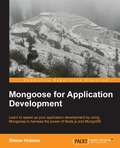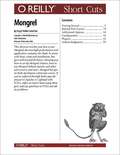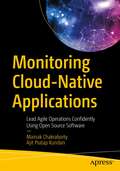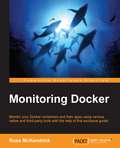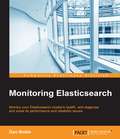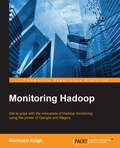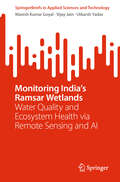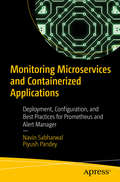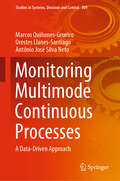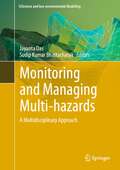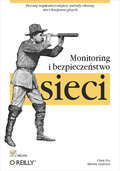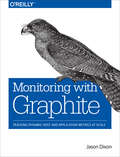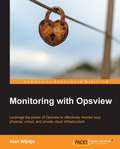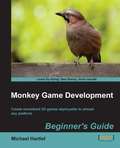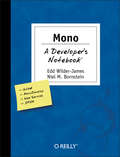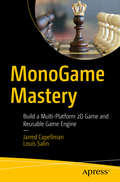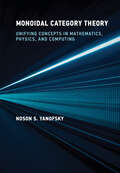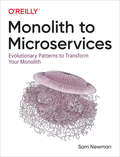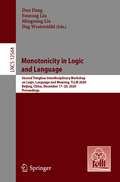- Table View
- List View
Mongoose for Application Development
by Simon HolmesThis book is a mini tutorial full of code examples and strategies to give you plenty of options when building your own applications with MongoDB.This book is ideal for people who want to develop applications on the Node.js stack quickly and efficiently. Prior knowledge of the stack is not essential as the book briefly covers the installation of the core components and builds all aspects of the example application. The focus of the book is on what Mongoose adds to you applications, so experienced Node.js developers will also benefit.
Mongrel
by Angel N. SciortinoThis shortcut teaches you how to use Mongrel, the new high-performance web application container for Rails. It starts with basic setup and installation, but goes well beyond the basics, showing you how to set up Mongrel clusters, how to use Mongrel behind Apache and other web servers, and more. Mongrel has given Rails developers a first-rate server. If you've suffered through Rails apps deployed on Apache or Lighttpd with FCGI, suffer no more! Start using Mongrel, and say good-bye to FCGI and all its problems.
Monitoring Cloud-Native Applications: Lead Agile Operations Confidently Using Open Source Software
by Ajit Pratap Kundan Mainak ChakrabortyIntroduce yourself to the nuances of modern monitoring for cloud-native applications running on Kubernetes clusters. This book will help you get started with the concepts of monitoring, introduce you to popular open-source monitoring tools, and help with finding the correct set of use cases for their implementation. It covers the in-depth technical details of open-source software used in modern monitoring systems that are tailor made for environments running microservices.Monitoring Cloud-Native Applications is divided into two parts. Part 1 starts with an introduction to cloud-native applications and the foundational concepts of monitoring. It then walks you through the various aspects of monitoring containerized workloads using Kubernetes as the de-facto orchestration platform. You will dive deep into the architecture of a modern monitoring system and look at its individual components in detail.Part 2 introduces you to popular open-source tools which are used by enterprises and startups alike and are well established as the tools of choice for industry stalwarts. First off, you will look at Prometheus and understand its architecture and usage. You will also learn about InfluxDB, formerly called TICK Stack (Telegraf, InfluxDB, Chronograf, and Kapacitor). You will explore the technical details of its architecture and the use cases which it solves. In the next chapter, you will be introduced to Grafana, a multi-platform open source analytics and interactive visualization tool that can help you with visualization of data and dashboards. After reading this book, you will have a much better understanding of key terminologies and general concepts around monitoring and observability. You will also be able to select a suitable monitoring solution from the bouquet of open-source monitoring solutions available for applications, microservices, and containers. Armed with this knowledge, you will be better prepared to design and lead a successful agile operations team.What You Will LearnMonitor and observe of metrics, events, logs, and tracesCarry out infrastructure and application monitoring for microservices architectureAnalyze and visualize collected dataUse alerting, reporting, and automated actions for problem resolutionWho This Book Is ForDevOps administrators, cloud administrators, and site reliability engineers (SREs) who manage and monitor applications and cloud infrastructure on a day-to-day basis within their organizations.
Monitoring Docker
by Russ MckendrickMonitor your Docker containers and their apps using various native and third-party tools with the help of this exclusive guide!About This BookGet the only book that covers multiple methods to monitoring Docker Containers -your one-stop solution to all your Docker monitoring needsLearn how to implement third-party tools such as Datalog, cAdvisor, and more with this example-rich, hands-on guideLearn how to efficiently monitor Docker containers and get an edge over other administrators while maintaining apps on these containersWho This Book Is ForThis book is for DevOps engineers and system administrators who manage Docker containers and want to better manage these containers using expert techniques and methods and better maintain applications built on Docker.What You Will LearnDiscover the tools built into Docker to gain an insight into your containers' performanceAugment Docker's built-in tools with modern tools such as cAdvisor from Google, SysDig by Draios, and Soundcloud's PrometheusIntegrate the monitoring of your containers with more traditional monitoring solutions such as ZabbixTake advantage of the various SaaS offerings from third parties to move monitoring away from your local infrastructure and into the cloudDiscover the various ways to ship your applications' logs from the container to a central logging serviceGet the most out of your application and resources with the right implementation of your monitoring methodIn DetailThis book will show you how monitoring containers and keeping a keen eye on the working of applications helps improve the overall performance of the applications that run on Docker. With the increased adoption of Docker containers, the need to monitor which containers are running, what resources they are consuming, and how these factors affect the overall performance of the system has become the need of the moment.This book covers monitoring containers using Docker's native monitoring functions, various plugins, as well as third-party tools that help in monitoring. Well start with how to obtain detailed stats for active containers, resources consumed, and container behavior. We also show you how to use these stats to improve the overall performance of the system. Next, you will learn how to use SysDig to both view your containers performance metrics in real time and record sessions to query later. By the end of this book, you will have a complete knowledge of how to implement monitoring for your containerized applications and make the most of the metrics you are collectingStyle and approachThis is an easy-to-follow guide with plenty of hands-on examples that can be executed both on your local machine and externally hosted services.
Monitoring Elasticsearch
by Dan NobleMonitor your Elasticsearch cluster's health, and diagnose and solve its performance and reliability issues About This Book * Understand common performance and reliability pitfalls in ElasticSearch * Use popular monitoring tools such as ElasticSearch-head, BigDesk, Marvel, Kibana, and more * This is a step-by-step guide with lots of case studies on solving real-world ElasticSearch cluster issues Who This Book Is For This book is for developers and system administrators who use ElasticSearch in a wide range of capacities. Prior knowledge of ElasticSearch and related technologies would be helpful, but is not necessary. What You Will Learn * Explore your cluster with ElasticSearch-head and BigDesk * Access the underlying data of the ElasticSearch monitoring plugins using the ElasticSearch API * Analyze your cluster's performance with Marvel * Troubleshoot some of the common performance and reliability issues that come up when using ElasticSearch * Analyze a cluster's historical performance, and get to the bottom of and recover from system failures * Use and install various other tools and plugins such as Kibana and Kopf, which is helpful to monitor ElasticSearch In Detail ElasticSearch is a distributed search server similar to Apache Solr with a focus on large datasets, a schema-less setup, and high availability. This schema-free architecture allows ElasticSearch to index and search unstructured content, making it perfectly suited for both small projects and large big data warehouses with petabytes of unstructured data. This book is your toolkit to teach you how to keep your cluster in good health, and show you how to diagnose and treat unexpected issues along the way. You will start by getting introduced to ElasticSearch, and look at some common performance issues that pop up when using the system. You will then see how to install and configure ElasticSearch and the ElasticSearch monitoring plugins. Then, you will proceed to install and use the Marvel dashboard to monitor ElasticSearch. You will find out how to troubleshoot some of the common performance and reliability issues that come up when using ElasticSearch. Finally, you will analyze your cluster's historical performance, and get to know how to get to the bottom of and recover from system failures. This book will guide you through several monitoring tools, and utilizes real-world cases and dilemmas faced when using ElasticSearch, showing you how to solve them simply, quickly, and cleanly. Style and approach This is a step-by-step guide to monitoring your ElasticSearch cluster and correcting performance issues. It is filled with lots of in-depth, real-world use-cases on solving different ElasticSearch cluster issues.
Monitoring Hadoop
by Gurmukh SinghThis book is useful for Hadoop administrators who need to learn how to monitor and diagnose their clusters. Also, the book will prove useful for new users of the technology, as the language used is simple and easy to grasp.
Monitoring India’s Ramsar Wetlands: Water Quality and Ecosystem Health via Remote Sensing and AI (SpringerBriefs in Applied Sciences and Technology)
by Manish Kumar Goyal Vijay Jain Utkarsh YadavThis book offers a comprehensive overview of water quality assessment and wetland health monitoring in India's Ramsar sites using remote sensing and artificial intelligence. Featuring detailed methodologies and case studies from both coastal and inland wetlands, it highlights innovative technologies and strategies for monitoring, restoration, and sustainable management. With a focus on practical applications, the book emphasizes the role of policy, technology, and community engagement in wetland conservation, serving as a valuable resource for researchers, practitioners, and decision-makers involved in ecosystem protection.
Monitoring Microservices and Containerized Applications: Deployment, Configuration, and Best Practices for Prometheus and Alert Manager
by Navin Sabharwal Piyush PandeyDiscover the methodologies and best practices for getting started with container services monitoring using Prometheus, AppDynamics, and Dynatrace. The book begins with the basics of working with the containerization and microservices architecture while establishing the need for monitoring and management technologies. You’ll go through hands-on deployment, configuration, and best practices for Prometheus. Next, you’ll delve deeper into monitoring of container ecosystems for availability, performance, and logs, and then cover the reporting capabilities of Prometheus. Further, you’ll move on to advanced topics of extending Prometheus including how to develop new use cases and scenarios. You’ll then use enterprise tools such as AppDynamics and Wavefront to discover deeper application monitoring best practices. You’ll conclude with fully automated deployment of the monitoring and management platforms integrated with the container ecosystem using infrastructure-as -code tools such as Jenkins, Ansible and Terraform. The book provides sample code and best practices for you to look at container monitoring from a holistic viewpoint. This book is a good starting point for developers, architects, and administrators who want to learn about monitoring and management of cloud native and microservices containerized applications. What You Will LearnExamine the fundamentals of container monitoringGet an overview of the architecture for Prometheus and Alert Manager Enable Prometheus monitoring for containers Monitor containers using Wavefront Use the guidelines on container monitoring with enterprise solutions AppDynamics and Wavefront Who This Book Is For Software developers, system administrators, and DevOps engineers working for enterprise customers who want to use monitoring solutions for their container ecosystems.
Monitoring Multimode Continuous Processes: A Data-Driven Approach (Studies in Systems, Decision and Control #309)
by Antônio José Silva Neto Marcos Quiñones-Grueiro Orestes Llanes-SantiagoThis book examines recent methods for data-driven fault diagnosis of multimode continuous processes. It formalizes, generalizes, and systematically presents the main concepts, and approaches required to design fault diagnosis methods for multimode continuous processes. The book provides both theoretical and practical tools to help readers address the fault diagnosis problem by drawing data-driven methods from at least three different areas: statistics, unsupervised, and supervised learning.
Monitoring and Managing Multi-hazards: A Multidisciplinary Approach (GIScience and Geo-environmental Modelling)
by Jayanta Das Sudip Kumar BhattacharyaTo monitor multi-hazards, Remote Sensing and GIS-based multi-criteria decision-making (MCDM) techniques have been extensively used in recent years worldwide. Since natural hazards cannot be eliminated, only quantification of these events and reliable forecasting can alleviate their detrimental effects, through which we can build more resilient and safe societies. Moreover, cultivating the proper knowledge of the multi-hazards and their monitoring and management can fill the gap between science, policy, and the community concerned. In an endeavor to understand and characterize the various hazards, Monitoring and Managing Multi-hazards: A Multidisciplinary approach presents a synthesis of what cross-disciplinary researchers know about these hazards and indigenous adaptation strategies.The book therefore focuses on the use of precision techniques, Remote Sensing, and GIS technologies to quantify various natural, environmental and social hazards along with the capacity building and sustainable mitigation strategies towards resilient societies. It encompasses both thematic and regional case studies to highlight the dynamicity of climate change, change of natural resources, landscape, water, river, agricultural, and social ecosystems at various spatio-temporal scales, including theoretical and applied aspects. The book gives readers an overview and analysis of traditional and advanced geospatial technologies on atmospheric, lithospheric, hydrosphere, biospheric and socio-economic contexts, on all spatial and temporal scales regarding hazards and disasters and sustainable development and management for the future.
Monitoring i bezpieczeństwo sieci (in Polish)
by Chris Fry Martin NystromPoznaj najskuteczniejsze metody obrony sieci korporacyjnych Jak stworzy?
Monitoring of Desert Locust in Africa and Asia
by Yingying Dong Longlong Zhao Wenjiang HuangThis book deals with the topic on remote sensing monitoring of desert locust in Africa and Asia. Remote sensing monitoring of the occurrence and damage of desert locust is conducted by integrating cutting-edge technologies and methods in cross-disciplinary fields in remote sensing science, geographic information science, agronomy, plant protection, agricultural meteorology, mathematics, and computer science. The main contents include spatio-temporal data analysis and processing, desert locust breeding areas monitoring, pest migration path analysis and damage monitoring. Moreover, a desert locust remote sensing monitoring system is constructed and applied in the region of Africa and Asia countries. This book not only provides technical reference for remote sensing monitoring and application of desert locust but also serves as a research reference for scholars and graduate students engaged in agricultural remote sensing, agricultural information technology, plant protection and other related field. It will help to improve remote sensing monitoring and application of desert locust.
Monitoring with Ganglia: Tracking Dynamic Host and Application Metrics at Scale
by Robert Alexander Matt Massie Bernard Li Brad Nicholes Vladimir Vuksan Jeff Buchbinder Frederiko Costa Alex Dean Dave Josephsen Peter Phaal Daniel PocockWritten by Ganglia designers and maintainers, this book shows you how to collect and visualize metrics from clusters, grids, and cloud infrastructures at any scale. Want to track CPU utilization from 50,000 hosts every ten seconds? Ganglia is just the tool you need, once you know how its main components work together. This hands-on book helps experienced system administrators take advantage of Ganglia 3.x.Learn how to extend the base set of metrics you collect, fetch current values, see aggregate views of metrics, and observe time-series trends in your data. You’ll also examine real-world case studies of Ganglia installs that feature challenging monitoring requirements.Determine whether Ganglia is a good fit for your environmentLearn how Ganglia’s gmond and gmetad daemons build a metric collection overlayPlan for scalability early in your Ganglia deployment, with valuable tips and adviceTake data visualization to a new level with gweb, Ganglia’s web frontendWrite plugins to extend gmond’s metric-collection capabilityTroubleshoot issues you may encounter with a Ganglia installationIntegrate Ganglia with the sFlow and Nagios monitoring systemsContributors include: Robert Alexander, Jeff Buchbinder, Frederiko Costa, Alex Dean, Dave Josephsen, Peter Phaal, and Daniel Pocock. Case study writers include: John Allspaw, Ramon Bastiaans, Adam Compton, Andrew Dibble, and Jonah Horowitz.
Monitoring with Graphite: Tracking Dynamic Host and Application Metrics at Scale
by Jason DixonGraphite has become one of the most powerful monitoring tools available today, due to its ease of use, rapid graph prototyping abilities, and a friendly rendering API. With this practical guide, system administrators and engineers will learn how to use this open source tool to track operational data you need to monitor your systems, as well as application-level metrics for profiling your services.Author Jason Dixon, member of the Graphite project, provides a thorough introduction of Graphite from the basics to the skills and tools you need for troubleshooting and scaling out its software components. If you want to learn more about monitoring systems, services, or applications, this is the book you need.Get an introduction to monitoring, including important concepts and terminologyExamine the features and functionality of key Graphite components, including Carbon and WhisperLearn the typical user workflow necessary to create a basic line chartBuild complex charts with chained functions and multiple axes that interact directly with the rendering APIUnderstand how to use the native Graphite dashboard, as well as the more popular third-party dashboardsMaster the art of scaling and troubleshooting high-performance or highly available Graphite clusters
Monitoring with Opsview
by Alan WijntjeA practical and fast-paced guide that gives you all the information you need to get up and running with Opsview.This book is for anyone interested in using Opsview as a potential monitoring solution or for those who are already running Opsview Core and who would like to improve on their setup by exploring the features of Pro and Enterprise. Some working knowledge of monitoring and Linux is assumed, and it is recommended to have an Opsview system at hand while reading, allowing you to immediately try out the features discussed.
Monitorowanie otoczenia z Arduino
by Emily Gertz Patrick Di JustoZbuduj w?asne urz?dzenia pomiarowe z platform? Arduino!Arduino to niesamowita platforma, która otworzy?a przed ?wiatem elektroniki mnóstwo nowych mo?liwo?ci. Dzi?ki prostocie obs?ugi zdoby?a rzesz? zwolenników, a to prze?o?y?o si? na ilo?? dost?pnych w sieci materia?ów i publikacji. Dla platformy Arduino opracowano liczne akcesoria, które pozwalaj? u?ytkownikowi rozbudowa? ka?dy uk?ad. Dodatkowo istnieje te? mo?liwo?? po??czenia jej z kolejn? popularn? platform? — Raspberry Pi. Z tym duetem osi?gniesz wszystko!Ten fantastyczny podr?cznik poka?e Ci, jak wykorzysta? Arduino do zbierania informacji o otaczaj?cym ?wiecie. Pomiar poziomu ha?asu, temperatury i wilgotno?ci to tylko cz??? projektów, które mo?esz zrealizowa? dzi?ki tej platformie. W trakcie lektury dowiesz si?, jak wykorzysta? modu? sieciowy oraz zaprezentowa? zebrane dane na wy?wietlaczu. Chcia?by? mie? swój w?asny licznik Geigera? To cudo jest w Twoim zasi?gu! Podczas realizacji przedstawionych tu projektów poznasz platform? Arduino i zaczniesz tworzy? w?asne uk?ady. Si?gnij po t? ksi??k? i zanurz si? w ?wiat uk?adów elektronicznych.Zbuduj swój w?asny: termometr miernik ha?asu licznik Geigera wymarzony uk?ad z platform? Arduino!Arduino — Twoja przepustka do ?wiata elektroniki!
Monkey Game Development: Beginner's Guide
by Michael HartlefThe first two chapters will provide you with grounding in Monkey. In each subsequent chapter you will create a complete game deployable to either iOS, Android, HTML5, FLASH, OSX, Windows and XNA. The last chapter will show you how to monetize the games so you can be commercially successful in the app development world. Do you want to quickly create games deployable to all the major desktop and mobile platforms?, if so look no further. You will learn how to utilize the highly versatile Monkey compiler to create 2d games deployable almost anywhere. No game development or programming experience is required.
Mono: A Developer's Notebook (Developer's Notebook)
by Niel M. Bornstein Edd Wilder-JamesThe Mono Project is the much talked-about open source initiative to create a Unix implementation of Microsoft's .NET Development Framework. Its purpose is to allow Unix developers to build and deploy cross-platform .NET applications. The project has also sparked interest in developing components, libraries and frameworks with C#, the programming language of .NET.The controversy? Some say Mono will become the preferred platform for Linux development, empowering Linux/Unix developers. Others say it will allow Microsoft to embrace, extend, and extinguish Linux. The controversy rages on, but--like many developers--maybe you've had enough talk and want to see what Mono is really all about.There's one way to find out: roll up your sleeves, get to work, and see what you Mono can do. How do you start? You can research Mono at length. You can play around with it, hoping to figure things out for yourself. Or, you can get straight to work with Mono: A Developer's Notebook--a hands-on guide and your trusty lab partner as you explore Mono 1.0.Light on theory and long on practical application, Mono: A Developer's Notebook bypasses the talk and theory, and jumps right into Mono 1.0. Diving quickly into a rapid tour of Mono, you'll work through nearly fifty mini-projects that will introduce you to the most important and compelling aspects of the 1.0 release. Using the task-oriented format of this new series, you'll learn how to acquire, install, and run Mono on Linux, Windows, or Mac OS X. You'll work with the various Mono components: Gtk#, the Common Language Runtime, the class libraries (both .NET and Mono-provided class libraries), IKVM and the Mono C# compiler. No other resource will take you so deeply into Mono so quickly or show you as effectively what Mono is capable of.The new Developer's Notebooks series from O'Reilly covers important new tools for software developers. Emphasizing example over explanation and practice over theory, they focus on learning by doing--you'll get the goods straight from the masters, in an informal and code-intensive style that suits developers. If you've been curious about Mono, but haven't known where to start, this no-fluff, lab-style guide is the solution.
MonoGame Mastery: Build a Multi-Platform 2D Game and Reusable Game Engine
by Jarred Capellman Louis SalinMaster the art of game creation with MonoGame—the cross-platform framework of choice for independent developers. Learn the various aspects needed to create your next game by covering MonoGame framework specifics, engine creation, graphics, patterns, and more. The MonoGame framework provides an incredible canvas for the programmer to create their next 2D game, and this book teaches you to make the most of it. You will start from the ground up, beginning with the basics of what MonoGame is, the pipeline, and then how to build a reusable game engine on top of the framework. You will deep dive into various components of each aspect of a game, including graphics, input, audio, and artificial intelligence. The importance of game tooling is also covered. By the end, you will have a mastery level of understanding of how to create a 2D game using MonoGame. With a fully functional 2D game, aspiring developers will have the ideal blueprint to tackle their next fully featured game. The material covered is applicable for almost any 2D game project ranging from side scrolling adventures to fighting games. What You Will Learn Learn to build a game with the MonoGame framework.Understand game engine architecture and how to build an engine onto the MonoGame framework.Grasp common design patterns used in game development and in fully featured engines, such as Unity. Who This Book Is For Beginner to advanced MonoGame programmer would find this book helpful. The audience is expected to have a working knowledge of C#.
Monochromatic HDR Photography: Shooting And Processing Black And White High Dynamic Range Photos
by Harold DavisUpdate: The Kindle version of Monochromatic HDR Photography: Shooting and Processing Black & White High Dynamic Range Photos currently available for sale has been corrected and updated to address formatting issues. Monochromatic HDR Photography is the first book intended to show photographers how to work at the intersection of two up-and-coming trends that are at the forefront of the digital revolution: Black & White and High Dynamic Range imaging. The book explains techniques for extending dynamic range, monochromatic conversion methods and best practices where the two technologies intersect. Since successful digital monochromatic image creation generally requires using the color information inherent in RAW exposures, most case studies will be presented in full color. In addition, Monochromatic HDR Photography provides extensive coverage of the creative vision required to successfully create monochromatic HDR images and the workflow necessary to make art prints from this specialized image making technique.
Monoidal Category Theory: Unifying Concepts in Mathematics, Physics, and Computing
by Noson S. YanofskyA comprehensive, cutting-edge, and highly readable textbook that makes category theory and monoidal category theory accessible to students across the sciences.Category theory is a powerful framework that began in mathematics but has since expanded to encompass several areas of computing and science, with broad applications in many fields. In this comprehensive text, Noson Yanofsky makes category theory accessible to those without a background in advanced mathematics. Monoidal Category Theorydemonstrates the expansive uses of categories, and in particular monoidal categories, throughout the sciences. The textbook starts from the basics of category theory and progresses to cutting edge research. Each idea is defined in simple terms and then brought alive by many real-world examples before progressing to theorems and uncomplicated proofs. Richly guided exercises ground readers in concrete computation and application. The result is a highly readable and engaging textbook that will open the world of category theory to many. Makes category theory accessible to non-math majorsUses easy-to-understand language and emphasizes diagrams over equationsIncremental, iterative approach eases students into advanced conceptsA series of embedded mini-courses cover such popular topics as quantum computing, categorical logic, self-referential paradoxes, databases and scheduling, and knot theoryExtensive exercises and examples demonstrate the broad range of applications of categorical structures Modular structure allows instructors to fit text to the needs of different courses Instructor resources include slides
Monolith to Microservices: Evolutionary Patterns to Transform Your Monolith
by Sam NewmanHow do you detangle a monolithic system and migrate it to a microservice architecture? How do you do it while maintaining business-as-usual? As a companion to Sam Newman’s extremely popular Building Microservices, this new book details a proven method for transitioning an existing monolithic system to a microservice architecture.With many illustrative examples, insightful migration patterns, and a bevy of practical advice to transition your monolith enterprise into a microservice operation, this practical guide covers multiple scenarios and strategies for a successful migration, from initial planning all the way through application and database decomposition. You’ll learn several tried and tested patterns and techniques that you can use as you migrate your existing architecture.Ideal for organizations looking to transition to microservices, rather than rebuildHelps companies determine whether to migrate, when to migrate, and where to beginAddresses communication, integration, and the migration of legacy systemsDiscusses multiple migration patterns and where they applyProvides database migration examples, along with synchronization strategiesExplores application decomposition, including several architectural refactoring patternsDelves into details of database decomposition, including the impact of breaking referential and transactional integrity, new failure modes, and more
Monomial Ideals and Their Decompositions (Universitext)
by Mark Rogers Sean Sather-Wagstaff W. Frank MooreThis textbook on combinatorial commutative algebra focuses on properties of monomial ideals in polynomial rings and their connections with other areas of mathematics such as combinatorics, electrical engineering, topology, geometry, and homological algebra. Aimed toward advanced undergraduate students and graduate students who have taken a basic course in abstract algebra that includes polynomial rings and ideals, this book serves as a core text for a course in combinatorial commutative algebra or as preparation for more advanced courses in the area. The text contains over 600 exercises to provide readers with a hands-on experience working with the material; the exercises include computations of specific examples and proofs of general results. Readers will receive a firsthand introduction to the computer algebra system Macaulay2 with tutorials and exercises for most sections of the text, preparing them for significant computational work in the area. Connections to non-monomial areas of abstract algebra, electrical engineering, combinatorics and other areas of mathematics are provided which give the reader a sense of how these ideas reach into other areas.
Monotonic and Ultra-Low-Cycle Fatigue Behaviour of Pipeline Steels: Experimental and Numerical Approaches
by Renato Natal Jorge António Augusto Fernandes Abílio M.P. JesusThis book covers the development of innovative computational methodologies for the simulation of steel material fracture under both monotonic and ultra-low-cycle fatigue. The main aspects are summarised as follows: i) Database of small and full-scale testing data covering the X52, X60, X65, X70 and X80 piping steel grades. Monotonic and ULCF tests of pipe components were performed (buckled and dented pipes, elbows and straight pipes). ii) New constitutive models for both monotonic and ULCF loading are proposed. Besides the Barcelona model, alternative approaches are presented such as the combined Bai-Wierzbicki-Ohata-Toyoda model. iii) Developed constitutive models are calibrated and validated using experimentally derived testing data. Guidelines for damage simulation are included. The book could be seen as a comprehensive repository of experimental results and numerical modeling on advanced methods dealing with Ultra Low Cycle Fatigue of Pipelines when subjected to high strain loading conditions.
Monotonicity in Logic and Language: Second Tsinghua Interdisciplinary Workshop on Logic, Language and Meaning, TLLM 2020, Beijing, China, December 17-20, 2020, Proceedings (Lecture Notes in Computer Science #12564)
by Fenrong Liu Mingming Liu Dun Deng Dag WesterståhlEdited in collaboration with FoLLI, the Association of Logic, Language and Information this book constitutes the refereed proceedings of the Second Interdisciplinary Workshop on Logic, Language, and Meaning, TLLM 2020, held in Tsinghua, China, in December 2020. The 12 full papers together presented were fully reviewed and selected from 40 submissions.Due to COVID-19 the workshop will be held online.The workshop covers a wide range of topics where monotonicity is discussed in the context of logic, causality, belief revision, quantification, polarity, syntax, comparatives, and various semantic phenomena in particular languages.
